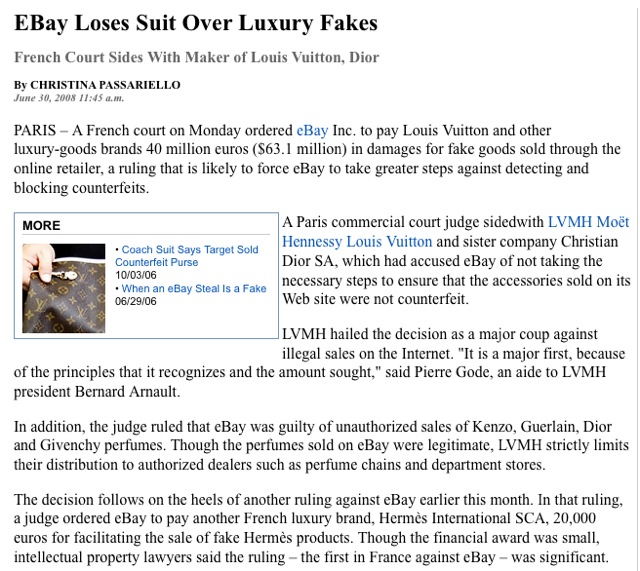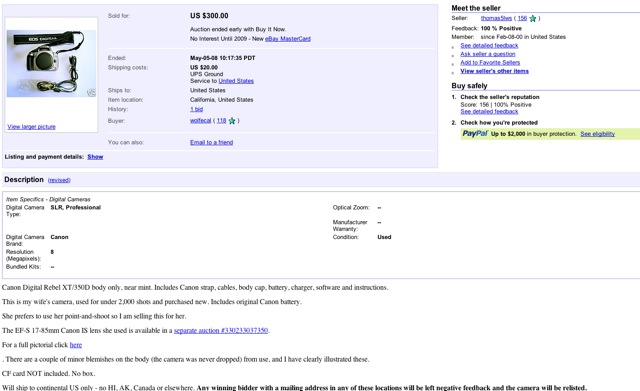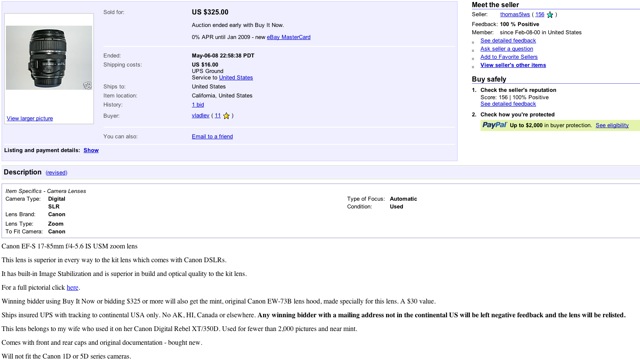Vive La France!
Unless you are a collector, it’s a solid practice to check that closet full of photo gear annually and sell anything untouched since you last looked. That especially applies to film gear which will very shortly become a genre for collectors only, as there will be no more film. Dump it now!
The very worst place to sell anything is eBay. You are selling to an ethically challenged audience though an auctioneer who disclaims any liability for anything. eBay is like the gun dealer who holds himself innocent because, after all, he did not pull the trigger. (Please, no lectures on the Second Amendment – any modern, civil society which permits handgun ownership is anything but a civil society).
Mercifully the French (no way the US tort-owned legal system would ever do this) have seen through this little game, as the WSJ reported yesterday:

In the US there are many amateur photo oriented sites which cater to classified ads, and you will not have to pay 15% in fees to eBay/PayPal in the process. My experience with these has been consistently good. They include:
- Fredmiranda.com – if you can ever get them to actually post your ad. Lots of Canon DSLR gear, much of it higher end
- Photo.net – some of the dumbest chat boards ever (Nikon v Canon garbage predominates), but sales are easy
- Your local Craigslist.com – cheap (free!) and easy, but less photo oriented, obviously
- Rff.com – mostly Leica and RF gear
Doubtless there are many others. Sure, they don’t offer fraud insurance but, then again, ask yourself why eBay feels the need to offer this.
A couple of years back when I sold all my film gear (phew! prices have crashed since) I did much of that on eBay because that’s all there really was. The alternatives did not have sufficient followings to constitute a broad market opportunity. That is changing.
In the meanwhile, if you must list on eBay, here are some of the steps I took to avoid being trapped by the ethically challenged:
- No sales to foreigners – yes, that includes Canadians and the UK. (To make Canadians and Englishmen feel better, the same rule applies at your end). Dispute resolution is doubly difficult, multiple legal systems come in to play and you really want to do all those custom forms and constantly be asked to under-declare value, making you a felon? Eastern Europe? Don’t make me laugh. That’s where you go for illicit anything. Stick with the US and forget AK and HI where you will always lose money on fixed postage estimates. The US contains 100 million of the world’s most affluent consumers. What’s not to like?
- Mail all packages UPS insured and make it clear in your ad that any damage in transit is the buyer’s responsibility and that the buyer must file the insurance claim with UPS. UPS makes this optional and you do not want to be the one filing the claim.
- Overpack. Bubble wrap is cheap. “It arrived damaged” is Scam #1.
- Keep and provide UPS tracking information – “I never received it” is Scam #2.
- When listing make an extra effort to take the highest quality pictures and be fastidious about illustrating any dings, defects, etc. “You didn’t tell me about the ding, etc.” is Scam #3.
- No returns. Ever. You want to loan your gear to a crook? “I need to return it” is Scam #4, and means the buyer got remorse (the spouse found out, likely as not) or used the camera for the weekend wedding and now wants his money back.
- Don’t list for $1 hoping for the best. Set a realistic minimum selling price, make the listing for 7 days and make sure it ends on a Sunday afternoon. That’s when most buyers have time to look at their computers, which enhances the possibilities of a last minute bidding war. You will get fewer bids, but then an opening bid of $1 is not a bid (unless you are really unlucky and it sells for that!). Multiple bids do not correlate with the best selling price. One good one will do. Still, if you like excitement, list at $1 and keep your fingers crossed. You will not do as well as I will.
- Don’t use price reserves. Would you bid on something whose price is unknown? Plus, reserves cost extra. Use minimum selling prices as described above.
- Be realistic about setting a minimum bid price. I generally look at completed auctions (active listings are useless as the price is not known), check a few other sites and set the starting price at 80% of the expected selling price. My failure rate (meaning no sale) was 5% using this approach, based on 40 listings.
- If selling a camera or lens, include some snaps taken with the gear. That says you are a user, not a clueless dealer, and sincere about the function of the equipment.
- Don’t waste money on listing enhancements like bold face and color. Educated buyers search by description, not listing appearance.
- If you start your listing at 80%, add a ‘Buy It Now’ option at 110%. This will attract buyers who really want your item and do not want the bidding war risk. Fully 40% of my auctions sold for the ‘Buy It Now’ price, generally within 24 hours of listing.
- Forget about making a killing. Price discovery in the market for used cameras is perfect, unless you are selling Oscar Barnack’s original Leica, in which case you need to use the higher class crooks at Sotheby’s and Christies.
- Don’t ever leave bad feedback. You will get in a time wasting argument and do nothing for your sale prospects down the road (because I guarantee that you will get retaliatory bad feedback, and good luck trying to get eBay to remove it), even if you were right. Saying nothing and swallowing your pride is the path to success here. Though, come to think of it, I just checked today and guess what?

So now, even if your buyer assaults you, he remains a good guy. Great system, huh?
- If you have high value outfits, it generally makes better sense to sell them piecemeal (body, lens, etc.) than as a kit. You will get better aggregate proceeds. Kits attract what I call the ‘kit discount’. Easier to sell as a kit, sure, but it’s your money.
- I sold some 40 items over one year and it took a while to learn the above. Since then the only complaint I have is the egregious fees charged by eBay and PayPal (which is owned by, you guessed it, eBay. Based on prior fines, PayPal is the place to launder your illicit drug proceeds – it’s nothing more than a poorly regulated bank, though in the US I suppose ‘poorly’ is axiomatic when it comes to the methadone cases who are bank regulators here).
In summary, if you start with the premise that you will be cheated and follow the steps above you will greatly mitigate the risks. Above all, be scrupulously honest in your listing.
Here’s an extract from my recent listing which applies the above rules:

No problem. The camera was as described, the buyer honest.
If you know a little HTML you can have hyperlinks to your detailed slideshow at your ISP – as above – avoiding eBay’s additional fees and securing a better presentation in the process. The pictures also serve as a perfect record in the event a fraudster alleges damage or other non-existent faults.
Now here’s the one for the lens:

Note the use of a free lens hood teaser if the buyer elects ‘Buy It Now’. The buyer of that one left me perfect feedback ….

…. then filed a claim with UPS alleging the goods were damaged. UPS paid him $300 and he got to keep the lens – see what I mean?
But, best of all, if you have fake gear to sell, list it on eBay because the US legal system will never do anything about it. And then you will be just another typical eBay seller.
And meanwhile, eBay and PayPal, I am pleased to add you to the Hall of Shame – a destination at which you arrived years ago.